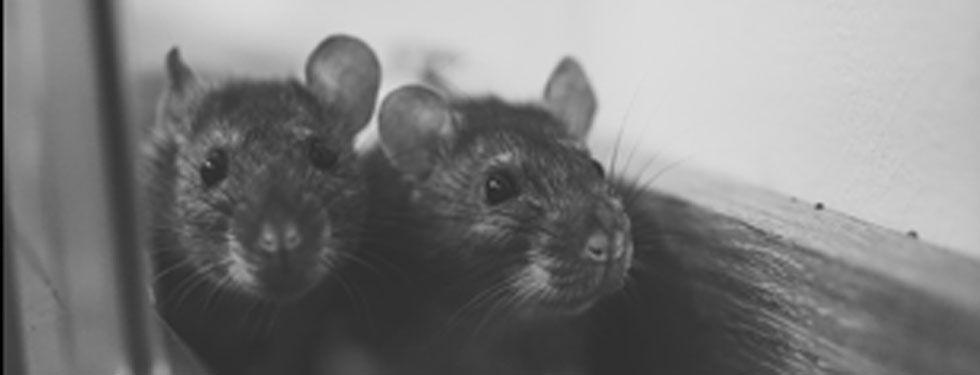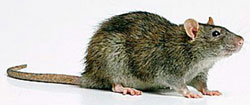Written by: Michael F. Potter and G. Mark Beavers
Rodents
Rats and mice are remarkably well-adapted for living in close association with humans. Three common species of rodents live in close association with humans: the Norway rat, roof rat, and house mouse.
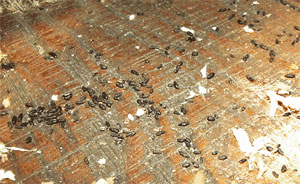
Mouse droppings (photo: tristatewildlife.com)
The greatest economic loss is not from how much these rodents eat but what must be thrown out because of damage or contamination. Food, clothing, furniture, books, and many other items are contaminated by their droppings and urine or damaged by their gnawing. Rodents damage doors, walls, insulation, and other structural components by their gnawing and burrowing. They also gnaw through utility pipes and electrical wiring, causing fires, indoor flooding, power outages, and equipment failure. Rats and mice can also transmit diseases, most notably salmonellosis (bacterial food poisoning), when food is contaminated by infected rodent feces. Other rodent-borne diseases include plague, murine typhus, rat-bite fever, rickettsial pox, and hantavirus.
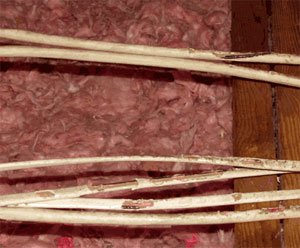
Wiring chewed by rats (photo: tristatewildlife.com)
[return]
Description, Biology, and Habits
The Norway rat, also called the brown or sewer rat, is the largest domestic rodent. An adult weighs about 12 to 16 ounces. Its stocky body is covered with coarse, reddish brown fur. The head is small, with close-set ears and a blunt muzzle. The tail is shorter than the combined length of the head and body. Norway rats live about one year and reach sexual maturity in 2 to 3 months. Females have 4 to 6 litters each year with 6 to 12 young per litter.
Outdoors, Norway rats commonly nest in burrows alongside buildings, fences, and under bushes or debris. They use the same routes daily and their feet make a beaten path along the ground. Indoors, these rats prefer to nest in the lower portions of buildings in wall voids, underneath floors, in crawlspaces, and beneath or inside equipment or stored items.
Norway rats eat essentially the same foods as humans, including meats, vegetables, and cereal grains, as well as garbage. They require water each day when feeding on dry food. Rats tend to be more cautious than mice in their foraging and feeding habits. Their average foraging range from the nest is about 50-150 feet but will travel further if food or water is scarce. Like all commensal rodents, Norway rats are active primarily at night and prefer to travel along walls and edges rather than crossing open areas.
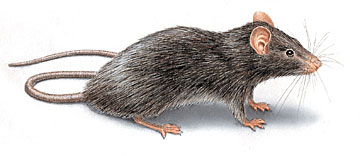
The tail of a roof rat is longer than its body
Roof rats are not common in Kentucky. These rats are smaller and sleeker than the Norway rat, weighing about 8 to 12 ounces when fully grown. The tail is longer than the combined length of the head and body, the muzzle is pointed, and the ears are large.
Roof rats are excellent climbers and are usually found above ground level. Nests may be located indoors, in attics, roof areas, or ceiling voids. They often enter buildings by using tree limbs, utility lines, or fences. They also nest outdoors, in trees, vines, or on the roof or sides of buildings. Occasionally, they will nest in underground burrows like the Norway rat. Roof rats consume many types of foods, but prefer vegetables, fruits, seeds, and cereal grains.
 The house mouse is the smallest domestic rodent (greenbeeremoval.com)
The house mouse is the smallest domestic rodent (greenbeeremoval.com)
The house mouse is the smallest domestic rodent. Adults are 2.5 to 3.5-inches long, with a 3- to 4-inch semi-hairless tail. They are gray to brown with large ears. Mice only live about a year but are prolific breeders. Females produce 6 to 10 litters continuously throughout the year with 4 to 7 young per litter.
House mice may live indoors or outdoors. Outdoors, they often live among weeds and shrubbery or near building foundations, inside garages, crawl spaces, or outbuildings. When food becomes scarce in the fall, mice often move indoors. Inside buildings, mice commonly nest within walls, ceiling, and cabinet voids, furniture, and large appliances.
Mice feed on a wide variety of foods but prefer seeds and cereal grains. They are also fond of foods high in fat and protein such as nuts, bacon, butter, and sweets (a useful point to remember when selecting baits for snap traps). Mice are "nibblers" and may make 20 to 30 visits to different food sites each night. Compared to rats, mice forage only short distances from their nests, usually not more than 10-25 feet. When food and shelter are adequate, their foraging range may be only a few feet. For this reason, traps and other control devices must be placed in areas where mouse activity is most apparent. Similar to rats, mice prefer to travel adjacent to walls and other edges (another important point to remember when positioning control devices). Mice are very inquisitive and will investigate each new object placed in their foraging territory. Therefore, if control devices are not initially successful, try moving them to a different location.
[return]
Control
You must "think like a rodent" to control them successfully. Keep in mind the behavioral traits noted above for each species. Begin with a thorough inspection of the premises, relying on the following signs as indicators of rodent activity:
Droppings
Droppings are the most common indicators of rodent presence and provide valuable clues where to place control devices. They are usually found where rodents travel, near their shelters, or other places rodents frequent. The shape and number of droppings can tell the species of rodent involved, the approximate size of the infestation, and whether the infestation is old or new. Fresh droppings are usually soft, shiny and dark but can harden in a matter of hours. Old droppings are dull and often covered with dust. Active infestations can best be determined by removing old droppings and noting the presence of new droppings.
Rat and mouse droppings are distinct:
- Adult Norway rat droppings are about 3/4-inch long and capsule-shaped, with blunt ends.
- Roof rat droppings are about 1/2-inch long and pointed on one end.
- Mouse droppings are 1/8- to 1/4-inch long with at least one of the ends pointed.
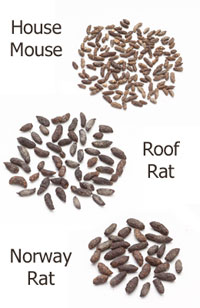
(www.motoco.com)
Runways/Rub Marks
Rodents are creatures of habit. They consistently use the same routes between food, water, and harborage. Outdoors, runways can be found next to walls, along fences, and under vegetation. Active runways are smooth, well packed, and free of vegetation. Indoors, runways may be found along walls, edges, and between stored items. As a rat moves along walls and through tight spaces, its body hairs often leave a dark, greasy deposit on surfaces. These "rubmarks" may be seen at ground level (along floor-wall junctions) or overhead beneath beams and rafters.
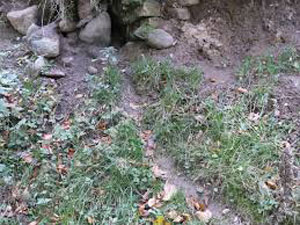 Norway rat burrow and run (www.masonspestcontrol.co.uk)
Norway rat burrow and run (www.masonspestcontrol.co.uk)
Burrows
The Norway rat prefers to nest in burrows, whereas the roof rat and house mouse only burrow occasionally. Rat burrows are usually found under concrete slabs, alongside building foundations, or beneath shrubbery and debris. Active burrows usually are smooth and compacted at the entrance, and free of dust and cobwebs. To determine if a burrow is active, stuff wads of paper into the opening or cave in the burrow with soil and recheck it the following day. Rat burrows usually consist of a main entrance and two or more "bolt" holes.
Tracks
Rodent footprints or tail marks can sometimes be found on dusty surfaces or in mud. To better see tracks in dust, hold a flashlight so that the beam is directed across the tracks at an angle. A tracking patch made of talc or flour can further help to determine if rodents are present.
Gnaw Marks
Mice and rats gnaw on all types of objects. Mice often gnaw small, clean-cut holes about one inch in diameter in boxes, bags, door sweeps, etc. Gnaw holes from rats are larger (about 2 inches in diameter), and often contain rough, torn edges. Rats often gnaw on the bottom of wood doors, joists, and other structural members.
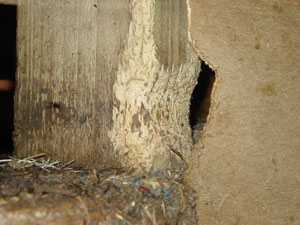
Rat-gnawing (www.maine.gov)
[return]
Sanitation
Rodents must have food and shelter to survive. Whatever can be done to limit availability of these essential resources will help to reduce rodent problems. This is especially true for rats, which require considerably more food, water, and shelter than do mice. Garbage should be kept in rodent-proof containers and picked up regularly. The same is true for pet food and bird seed. Weeds and unnecessary vegetation should be removed, especially when they are adjacent to building foundations. (Weed seeds are a favored food of mice and the vegetation serves as rodent harborage). Rubbish, lumber, rock piles, and old equipment should be eliminated, as should standing water. Where practical, boxes, crates, and other items should be stored at least 18 inches off the ground and 12 inches away from walls. Storing items in this manner makes them less attractive to rodents. It also makes it easier to inspect, clean, and install rodent control devices.
Rodent-Proofing
Along with proper sanitation, the best way to avoid rodent problems in buildings is to prevent their entry. Mice are able to squeeze through extremely small openings no wider than the diameter of a pencil (1/4-inch). Rats can enter through cracks the size of a quarter (1/2-inch). Cracks and openings under doors, around windows, in building foundations, vents, and where plumbing, electrical, and air conditioning lines enter the structure should all be sealed. Permanent sealants such as cement, sheet metal, and hardware cloth are preferred.
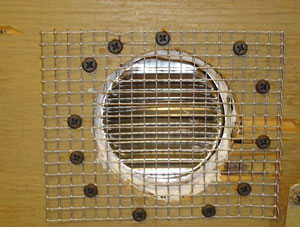
Exclude rodents with screens (www.doyourownpestcontrol.com)
[return]
Traps
Trapping can be a very effective form of rodent control, especially against mice. If signs indicate that you do not have a large rodent population, traps are generally preferred over pesticides because they are less hazardous to use around children and pets. In addition, because rodents are captured by the trap, they are not as likely to die in walls or other inaccessible areas and create odors. Snap traps are widely available and easy to use.Trapping efficiency can be enhanced by baiting the trigger with such foods as peanut butter, bacon, raisins, or fruit. Snap traps with an expanded trigger catch significantly more mice than conventional designs. Snap traps should be oriented perpendicular to the wall, with the trigger end against the vertical surface.
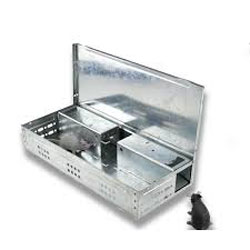 Multiple-catch trap (www.dhshouxin.com)
Multiple-catch trap (www.dhshouxin.com)Automatic multiple-catch traps are very effective against mice. Mice enter these traps out of curiosity for new objects placed in their territory. One type of multiple-catch trap requires winding and flips mice into a holding chamber. Another model operates using the principle of a trap door. Both devices can capture and hold several mice before needing to be emptied. Multiple-catch traps can be oriented with the entrance hole either perpendicular or parallel to the wall.
Glueboards
Glueboards are also very effective against rodents, especially mice. Mice become entangled in the glue when they run over the boards. Captured mice soon die of suffocation. Along with traps, glue boards are a preferred method of control in homes and other sensitive locations where pesticides are a concern. Glue traps can be purchased ready made, or can be custom made using bulk glue and plywood cut to varying sizes to fit the particular job requirements. Should the glue from a glue board contact the fur of a pet or the skin of a child, it can be removed with mineral or vegetable oil.
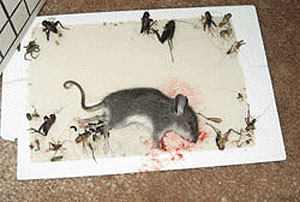
Using Traps Effectively
Regardless of the type of trap or glueboard that is used, they should be placed against walls, behind objects and appliances, and in secluded areas where droppings, damage, and other signs of rodents are evident. Rodent control devices should also be installed in areas where there is potential for rat or mouse entry (e.g., on both sides of exterior doors, and near utility openings in walls). Rodents have limited foraging ranges so it is important to use several trap placements. Traps and glue boards for mice should be spaced no more than 10 feet apart in areas where mouse activity is apparent, closer if the infestation is severe. Rat traps can be spaced 15 to 20 feet apart.
Traps and glue boards should be checked daily and dead rodents disposed of in plastic bags. Decomposing rodents attract flies, dermestids, and other insects which can lead to additional problems if not removed. Wear gloves when handling rodent carcasses to prevent any chance of disease spread. Record the location of each control device and which placements caught rodents. Keep trap catch records to identify areas of high rodent activity. Adjust the rodent control activities in these areas (e.g., adding more traps, exclusion, weed control) accordingly.
[return]
Rodenticides
Specific pesticides, known as rodenticides, are available for rodent control. The three main types are: poison baits, tracking powders, and fumigants.
Poison Baits
Poison baits are rodenticides that are formulated as food-based toxicants containing seeds or grain to attract the rodents. Many baits are anticoagulants that kill by interfering with normal clotting of the rodent's blood. This causes the rodent to die from internal bleeding. The newer anticoagulants are normally lethal to rodents after a single feeding. However, the rodent usually lives for 3 to 5 days before it dies. The older anticoagulants required several feedings and two or more weeks for death to occur.
There are some non-anticoagulant rodenticide baits. Most of them kill rodents after a single feeding. Some kill rodents in 2-3 days by causing paralysis. One causes an excess of calcium in the blood which leads to heart failure in 3-4 days. Zinc phosphide kills rodents in 1-24 hours by forming phosphine gas in the circulatory system.
Commercial baits, in pelleted or meal form, are available in sealed plastic, cellophane or paper packets (known as "place" packs), as loose bait, or molded into paraffin (wax) blocks. The wax block formulation is very useful for both outdoor and indoor baiting locations because it resists dampness and moisture.
Regardless of which bait formulation is used, be sure to place baits in areas that are inaccessible to children, pets, and wildlife or in tamper-resistant bait stations. Dogs, in particular, will seek out and find baits placed in areas that are accessible. Other than when placing baits directly into a rodent burrow, it makes good sense to confine baits in an enclosed bait box.
Bait boxes help to
- reduce accidental contact with people and non-target animals
- keep bait fresh by protecting it from dirt, moisture, and dust
- provide a protected and attractive place for rodents to feed
- allow label, company contact number, and other pertinent information to be provided at the baiting site.
If rodent baits must be installed in locations that are accessible to children and non-target animals, they must be placed in tamper-resistant bait boxes. These boxes are constructed of metal or non-crushable plastic, have a locking mechanism, and have a specific internal design that confines the bait within the station. In order to be considered truly tamper-resistant, the station must also be secured to the mounting substrate (ground, floor, wall, fence, etc.). This can be done with a stake, nail gun, length of chain, "liquid nails," or by securing the station to a weighted paving block.
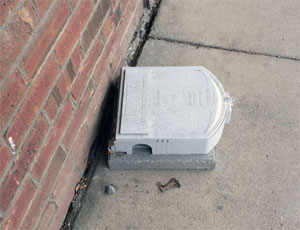 Tamper-proof bait box
Tamper-proof bait box
As with traps, proper bait placement is critical. Place bait in all areas suspected of harboring rodents, along routes of travel, and where they are likely to enter buildings. Several placements will produce better results than just a few. Baits that are not being fed upon may need to be repositioned. Rodent bait should be replaced at least monthly because rats and mice are not attracted to old, moldy bait.
Tracking Powder
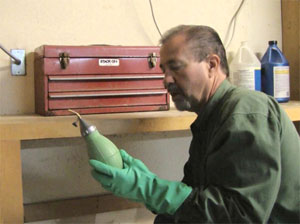 Using a hand duster to apply tracking powder
Using a hand duster to apply tracking powderSome rodenticides are formulated as "toxic dusts," known as tracking powders. Tracking powders may contain anticoagulants or non-anticoagulants. Small amounts of tracking powder are placed along rodent runways, burrows, wall voids, and other concealed locations, usually using a hand duster. Power dusters should not be used because they would spread the pesticide too widely. Rodents pick up the toxicant on their fur and feet and ingest it while grooming. Tracking powders are especially effective against mice, which groom themselves and their nestmates almost continuously. Tracking powders should only be placed in inaccessible areas or in the bottom of tamper-resistant bait stations. As with any pesticide, care must be taken not to contaminate food preparation surfaces or other surfaces that may be contacted by people or pets.
Fumigants
Certain rodenticides are also formulated as poisonous gases (fumigants). The most common use of these products is for gassing burrows. This is a fast and effective way to control burrowing rodents (e.g., Norway rats) in outdoor locations. Fumigants are extremely dangerous. Always read and follow pesticide label directions.
[return]
